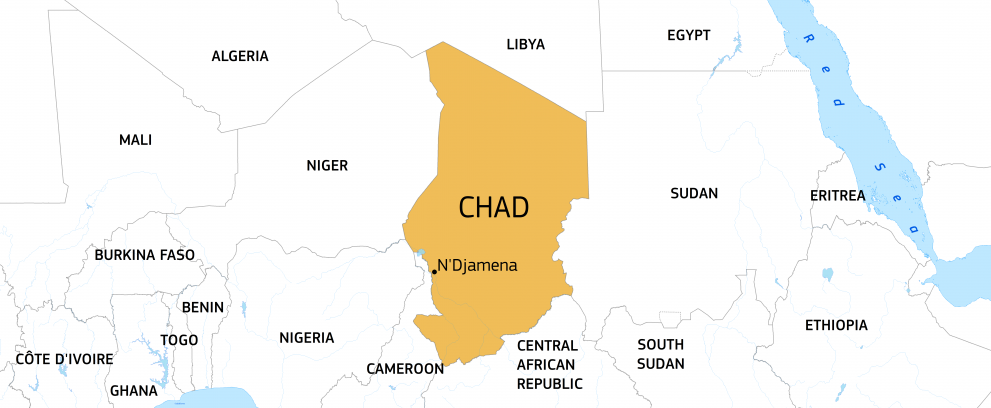Introduction
Chad, one of the world’s poorest countries, faces low development, limited social services, and climate hazards.
Humanitarian needs are soaring due to a mass influx of refugees and returning Chadians from Sudan, a protracted crisis in the Lake Province, and unprecedented food insecurity.
In this complex crisis, the EU has stepped up its humanitarian support, providing protection and emergency aid for forcibly displaced people, life-saving treatment for undernourished children, food assistance, and interventions to reduce environmental risks.
What are the needs?
Chad faces overlapping natural and manmade humanitarian crises, with 7 million people needing humanitarian aid in 2025. Even before Sudan’s war erupted in April 2023, Chad hosted one of the region’s largest refugee populations. With nearly 1 million new arrivals, the total forcibly displaced now exceeds 1.3million, including over 1.1 million Sudanese refugees, as well as refugees from the Central African Republic, Nigeria and Cameroon, and 220,000 returning Chadians.
In 2024, Chad declared a state of emergency over the worsening food crisis, further aggravated by the region’s worst floods, affecting 1.9 million people and destroying 356,000 hectares of cropland.
The number of people facing acute food insecurity in 2025 will further increase and has more than doubled since 2023. Over 4.3 million people are projected to suffer crisis and emergency levels of food insecurity during the lean season between June and August 2025. Among them are at least 600,000 refugees and returning Chadians who fled Sudan’s fighting.
Chad also hosts refugees from other countries, most notably from the Central African Republic, while conflict in the Lake Chad Basin has driven internal and cross-border displacements since 2015. Epidemics like measles, malaria and hepatitis E are constant threats.
As of February 2025, Chad has opened seven new camps for Sudanese refugees, but the influx exceeds capacity, and at least three more are required. Failing to meet the vital needs of refugees and vulnerable host populations could fuel inter-community tensions.

How are we helping?
The EU is one of the main humanitarian aid donors for people in need in Chad. In 2024, we stepped up support with over €85 million in humanitarian aid and allocated an additional €74.5 million in early 2025 to assist those most in need. Out of the total amount, €30 million is subject to the approval of the budgetary authority.
In the immediate aftermath of Sudan war, which erupted on 15 April 2023 and caused mass displacement, the EU swiftly responded by nearly doubling its 2023 allocation of humanitarian aid.
To strengthen its response, we mobilised the European Humanitarian Response Capacity (EHRC), organising multiple EU Humanitarian Air Bridge flights to deliver hundreds of tons of essential supplies to partners. We also rehabilitated the main airstrip in the border town of Adré to facilitate aid deliveries.
In partnership with HI/Atlas Logistique, we established a logistics hub in Adré to store and distribute humanitarian supplies. During the 2023 and 2024 rainy seasons, we deployed a helicopter, in partnership with the UN Humanitarian Air Service, to access hard-to-reach areas in eastern Chad.
To draw global attention to the crisis, the EU co-hosted the International Humanitarian Conference for Sudan and neighbouring countries in April 2024 alongside France and Germany and will co-host the London Sudan Conference, together with the United Kingdom, France, Germany and the African Union, on 15 April 2025, two years since the start of the armed conflict. The Conference will provide a platform to discuss the issues prolonging the conflict and causing devastating humanitarian impacts. .
In addition to addressing the basic needs of forcibly displaced populations, the EU also responds to sudden emergencies in overcrowded camps and host communities, such as epidemic outbreaks like Hepatitis E or fires destroying shelters and food supplies.
EU humanitarian aid focuses on urgent life-saving support, particularly for newly arrived refugees most of whom are women and children, while strengthening their resilience and promoting peaceful coexistence with host communities.
EU humanitarian aid is programmed in a Nexus approach. In the East of Chad, ECHO, INTPA and FPI have adopted a joint programming approach aiming at delivering drinking water in a sustainable way, shifting from food assistance to self-reliance, and preserving inter community social cohesion.
In addition, the EU continues to assist people affected by the ongoing violence and attacks in the Lake Chad region, where a worsening humanitarian and security situation is driving new displacements.
In response to the country’s food and nutrition crisis, the EU funds assistance such as cash transfers, vouchers, food rations, ready-to-use therapeutic foods, and essential medicines to treat severely malnourished children.
Key areas of support in Chad include:
- Food and nutrition assistance
- Protection for vulnerable individuals and families
- Health care and essential medicines
- Water, sanitation, and hygiene (WASH) services
- Shelter for displaced populations
- Education
- Multisectoral Rapid Response (RRM)
Whenever needed, the EU responds swiftly to new crises while also investing in disaster risk reduction, helping communities become less vulnerable to future shocks.
Finally, the EU funds the United Nations Humanitarian Air Service (UNHAS) in Chad, with flights that ensure aid workers can reach people in remote or crisis-affected areas.
Last updated: 10/04/2025
Facts & figures
(The numbers relative to the influx of refugees and returnees are constantly evolving and subject to change).
7 million people need humanitarian aid (Humanitarian Response Plan, 2025)
4.3 million people in acute food insecurity during the 2025 lean season (Harmonized Framework)
Chad has the 185th highest maternal mortality out of 188 countries
Over 1.3 million forcibly displaced people (UNHCR), including:
- Over 975,000 arrivals from Sudan since 15 April 2023, both refugees and returnees
- 220,000 internally displaced in the Lake Chad region
- 140,000 refugees from CAR, 22,000 from Nigeria, 8,500 from Cameroon.
EU humanitarian funding:
€74.5 million at the start of 2025 (out of which 30 million subject to the approval of the budgetary authority)
€85.5 million at the end of 2024

